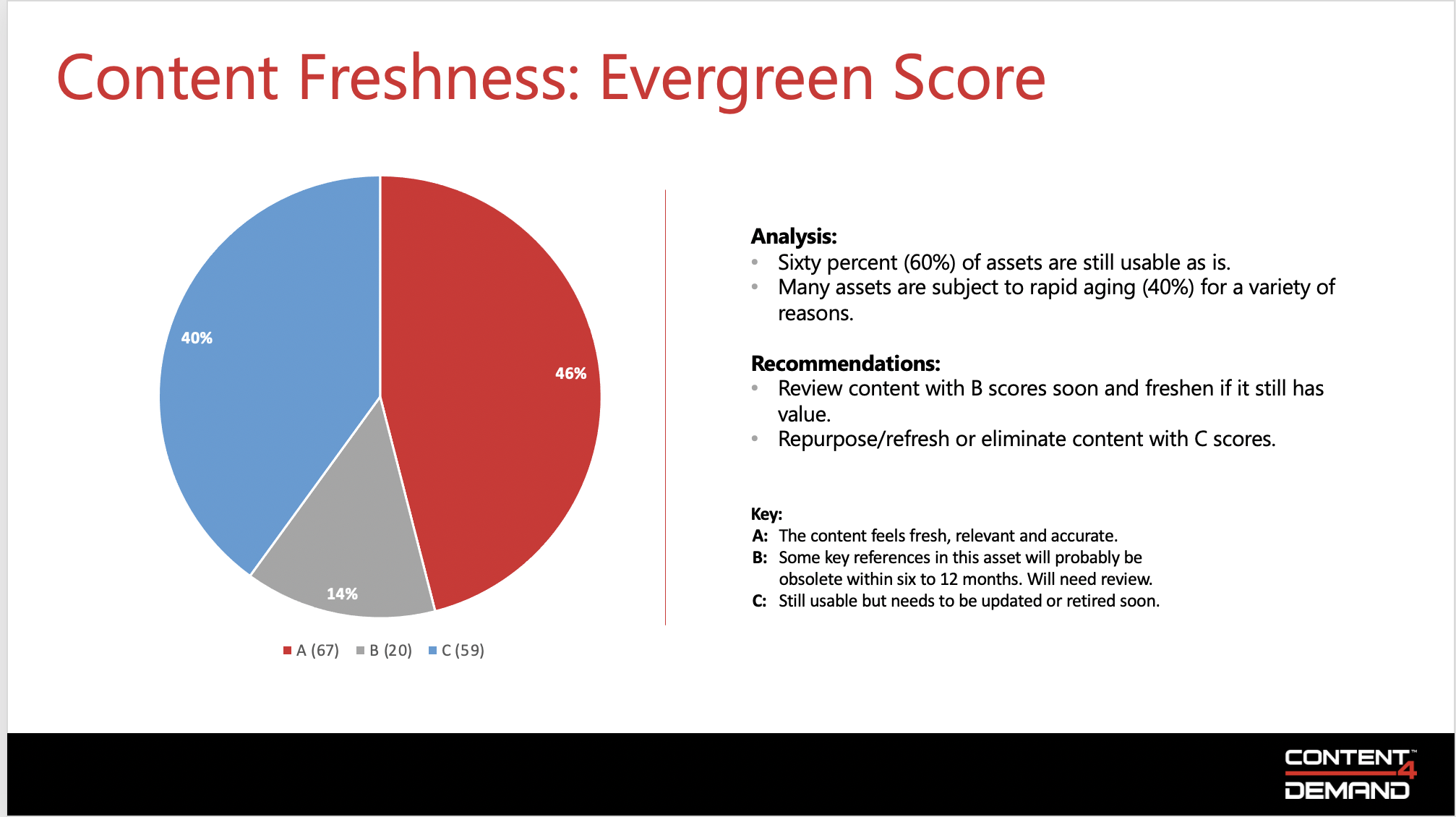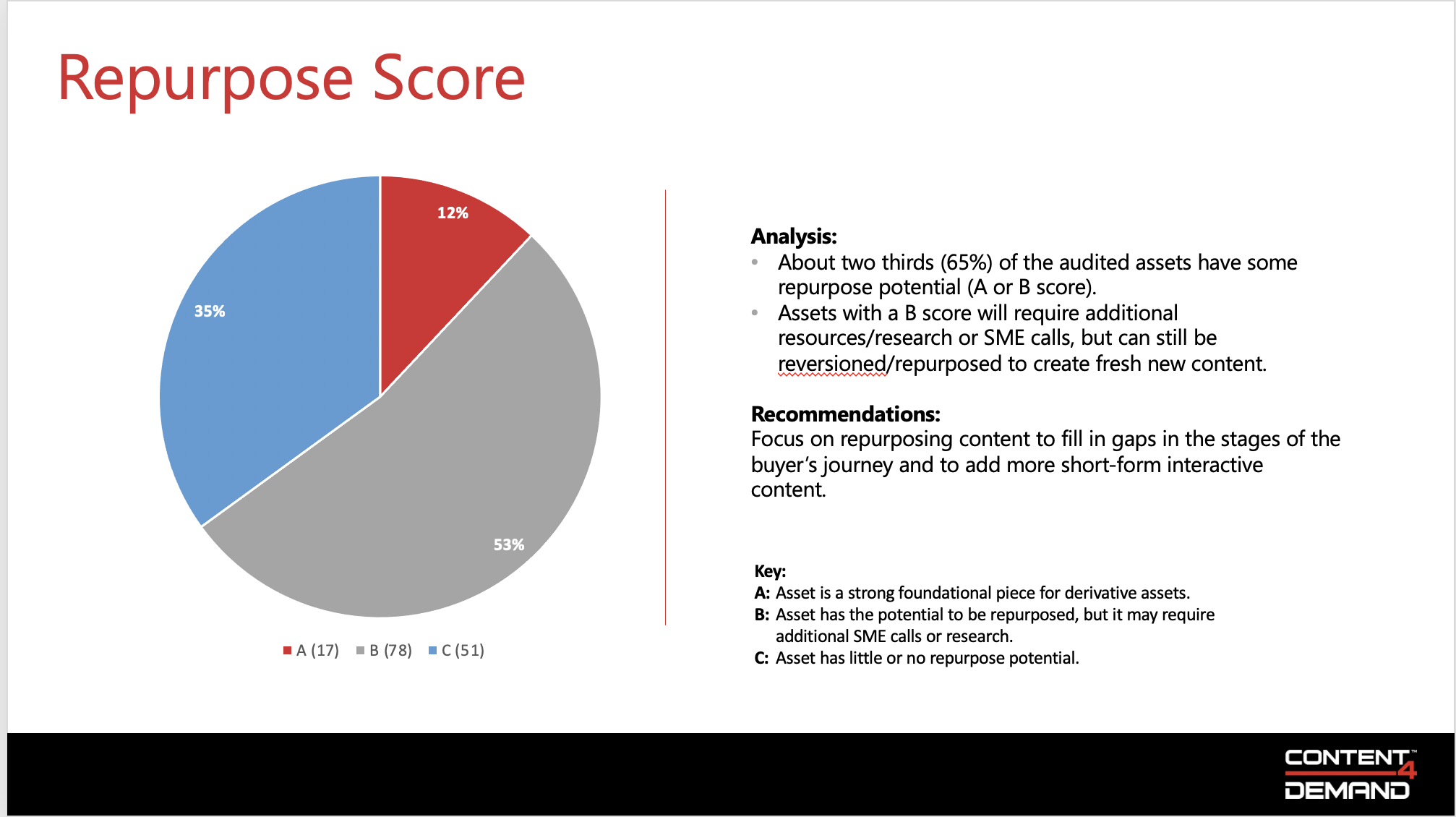At Content4Demand, we strongly advocate content audits to help content marketers get a complete view of their content library. With your content audit results, you can analyze what’s fresh, who the assets target, where that content fits in the buyer’s journey, where your gaps are and whatever other criteria you can imagine that can help you understand the value of your existing content.
But once you gather all this valuable information about your content library, what do you do with it? This is where you reap the real benefits of the audit.
Analyze Your Content Audit Results
With the audit completed, it’s time to make sense of the information you’ve gathered. If you’ve set up your audit spreadsheet correctly, you can now slice and dice the results to see exactly where you stand. Here are some things to look for:
- How much of the content is still fresh? Which assets are aging or completely outdated?
- Which personas are these assets targeting? Are they the right ones?
- Into which stages of the buyer’s journey do your assets fall?
- Which products or services are addressed in your content?
- Which assets are prime targets for repurposing?

Identify Your Gaps
Once you’ve performed your initial analysis, you can begin to dig deeper to see where your gaps lie. The filters in your audit spreadsheet will help you identify them.
- How many assets do you have for each product or service that can you can reversion or repurpose?
- How many assets that are still fresh are good candidates for reversioning or repurposing?
- How many assets do you have for each target persona in each stage of the buyer’s journey?
- How many evergreen or fresh assets do you have for each stage of the buyer’s journey?
- Do you have content in a wide variety of the formats your buyers prefer, or are there new formats you might leverage to reach more of your target audience?

Align Content with Marketing Strategy
Your next step is to compare your content audit results to your marketing plan to determine how to make the best use of your content library (or to develop a marketing plan if you don’t already have one!). This is a step you can return to every time you plan a new campaign or a new asset, browsing your audit results to find the assets with the best potential to achieve the results you’re after.
- Identify which products or services you plan to feature in your campaign(s).
- Nail down the themes that will run through your marketing campaigns to give them coherence and consistency.
- If you have new messaging that needs to be incorporated into content, make sure it’s buttoned up and ready to go.
- Consider any new personas or industries your sales and marketing team wants to target.
- List the goals of your marketing efforts, whether they include lead generation, nurture, customer retention, or cross-sell and upsell.

Develop Ideation
At this point, you can develop detailed ideation based on your content marketing objectives. After you identify the assets you want to create, look back to your audit results for existing assets you can use as is or with slight edits to reversion or repurpose them to save you development and production costs. Comparing your ideation to the audit will help you see exactly where you can leverage what you already have and what you need to create from scratch.
Refresh, Repurpose & Reversion
Now that you know exactly which existing content aligns with your marketing goals, you can use your content audit results to see what you need to do create the content you need.
Some content may be usable as is, with absolutely no changes. Some content may be usable with only moderate refreshing, reversioning, revising or additional information—updating that may only require an SME call or a little more research. A well-executed audit will give you these insights.

Get Creative
Here are some tips for using existing content with information that’s still relevant and important:
- Update statistics in existing assets with current information for a quick asset refresh.
- Turn static assets into interactive assets.
- Reversion usable assets for different personas, buying stages, different vertical markets.
- Pull short clips from videos and webinars to use on social media channels.
- Create short-form derivative content from white papers, webinars, research reports and other long-form content.
- Edit general assets that speak to multiple personas to create distinct, targeted pieces for one, some or all of your key personas.
- Refresh copy, images and/or design to reflect new messaging and branding.
- Use late-stage assets as resources to create sales enablement tools that bridge the marketing-sales gap.

Put Your Plan Into Action
Naturally, the next step is to start producing content. Adding a content audit into your content marketing efforts, you can stretch your budget, cut your content development time, extend the life of existing content and achieve your sales and marketing goals more efficiently and affordably.
If you haven’t completed a content audit, check out our interactive experience to learn more about 5 Steps to a Successful Content Audit.

Brenda Caine is a senior content strategist at Content4Demand. She works with B2B clients on content marketing strategy, personas, messaging and ideation; content audits, gap analysis and content mapping; blogs; content development and more. Brenda has a black belt in karate, and when she’s not immersed in technology, you can find her dancing in the ballet studio, lifting weights at the gym or strolling down the avenue in a 1930s dress with a smart hat to match.



